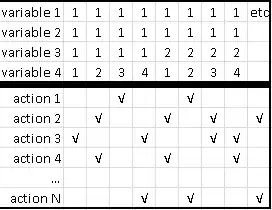I am running into a situation where my program can have different outcomes depending on the state of some variables. 4 variables are involved and they can all have different ( 3 to 4 different states). All the possible combinations are leading me to about 48 different cases which would be resolved using a 4 level deep nested if/else structure. So, I have a couple of questions,
Is there a better technique to draw logic or decision tables or some other structure so that you can model a decision tree for this many outcomes? When a decision is dependent on only 2 variables you can easily model this on a spreadsheet which is two dimensional by its nature but how do you deal with a case like the one I mentioned?
Other than a 4 level deep nested if/else structure is there a better programming technique to deal with this?
